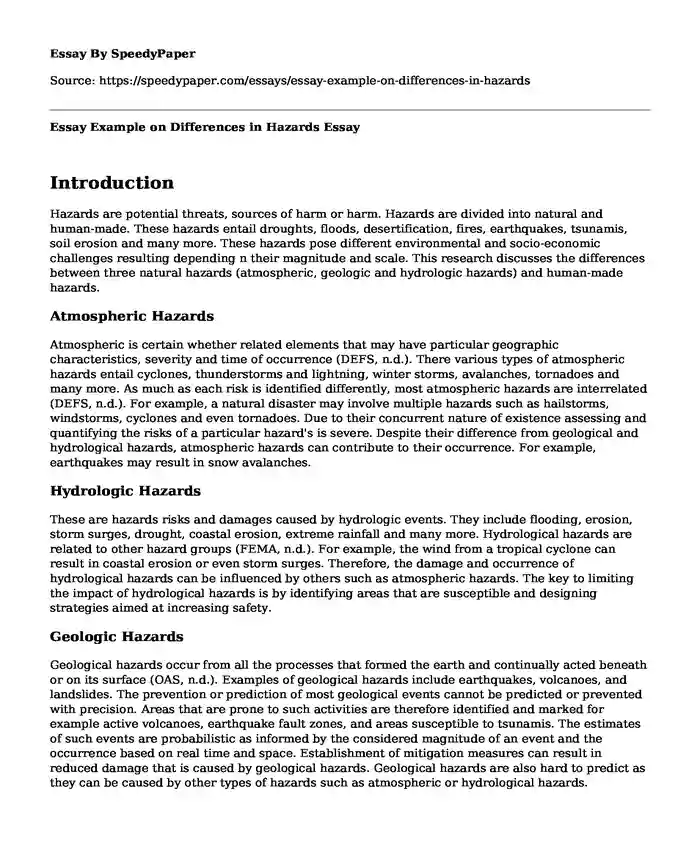
| Type of paper: | Essay |
| Categories: | Environment Disaster |
| Pages: | 3 |
| Wordcount: | 658 words |
Introduction
Hazards are potential threats, sources of harm or harm. Hazards are divided into natural and human-made. These hazards entail droughts, floods, desertification, fires, earthquakes, tsunamis, soil erosion and many more. These hazards pose different environmental and socio-economic challenges resulting depending n their magnitude and scale. This research discusses the differences between three natural hazards (atmospheric, geologic and hydrologic hazards) and human-made hazards.
Atmospheric Hazards
Atmospheric is certain whether related elements that may have particular geographic characteristics, severity and time of occurrence (DEFS, n.d.). There various types of atmospheric hazards entail cyclones, thunderstorms and lightning, winter storms, avalanches, tornadoes and many more. As much as each risk is identified differently, most atmospheric hazards are interrelated (DEFS, n.d.). For example, a natural disaster may involve multiple hazards such as hailstorms, windstorms, cyclones and even tornadoes. Due to their concurrent nature of existence assessing and quantifying the risks of a particular hazard's is severe. Despite their difference from geological and hydrological hazards, atmospheric hazards can contribute to their occurrence. For example, earthquakes may result in snow avalanches.
Hydrologic Hazards
These are hazards risks and damages caused by hydrologic events. They include flooding, erosion, storm surges, drought, coastal erosion, extreme rainfall and many more. Hydrological hazards are related to other hazard groups (FEMA, n.d.). For example, the wind from a tropical cyclone can result in coastal erosion or even storm surges. Therefore, the damage and occurrence of hydrological hazards can be influenced by others such as atmospheric hazards. The key to limiting the impact of hydrological hazards is by identifying areas that are susceptible and designing strategies aimed at increasing safety.
Geologic Hazards
Geological hazards occur from all the processes that formed the earth and continually acted beneath or on its surface (OAS, n.d.). Examples of geological hazards include earthquakes, volcanoes, and landslides. The prevention or prediction of most geological events cannot be predicted or prevented with precision. Areas that are prone to such activities are therefore identified and marked for example active volcanoes, earthquake fault zones, and areas susceptible to tsunamis. The estimates of such events are probabilistic as informed by the considered magnitude of an event and the occurrence based on real time and space. Establishment of mitigation measures can result in reduced damage that is caused by geological hazards. Geological hazards are also hard to predict as they can be caused by other types of hazards such as atmospheric or hydrological hazards.
Manmade Hazards
Man-made hazards are the events that are caused by the actions of man propagating symptoms of land, and the environment in general (El-Sabh & Murty, 2012). These hazards entail pollution, environmental degradation and accidents due to mans creations or infrastructure resulting in challenges such as are complex emergencies, climate change, displace populations, unplanned-urbanization, feminine, transport accidents and industrial accidents. The magnitude of the factors results influences the scale of the hazards. Man-made hazards have an interdependent relationship with natural hazards such as hydrologic, geologic and atmospheric hazards (El-Sabh & Murty, 2012). For example, the construction of a dam can trigger soil erosion.
Conclusion
Atmospheric, geological, hydrological and manmade hazards have a different prediction, estimation techniques and areas of prevalence. However, these hazards are also interrelated in one way or another. Natural hazards cannot be prevented, but the identification of sensitive area helps in reducing their effects.
References
Department of Fire and Emergency Services (DFES). (n.d.). Natural Hazards. Retrieved on 13th March 2019 from https://www.dfes.wa.gov.au/schooleducation/teachersandschools/NaturalHazards/DFES-Natural-Hazards-Overview-Lesson1.pdf
El-Sabh, M. I., & Murty, T. S. (Eds.). (2012). Natural and Man-Made Hazards: Proceedings of the International Symposium held at Rimouski, Quebec, Canada, 3-9 August 1986. Springer Science & Business Media.Federal Emergency Management Agency (FEMA). (n.d.). Hydrologic Hazards. Retrieved on 12th March 2019 from https://www.fema.gov/media-library-data/20130726-1545-20490-4641/mhira_n3.pdf
Organization of American States-OAS. (n.d.). Geologic Hazards. Retrieved on 13th March 2019 from http://www.oas.org/dsd/publications/unit/oea66e/ch11.htm
Cite this page
Essay Example on Differences in Hazards. (2022, Dec 11). Retrieved from https://speedypaper.com/essays/essay-example-on-differences-in-hazards
Request Removal
If you are the original author of this essay and no longer wish to have it published on the SpeedyPaper website, please click below to request its removal:
- Fast Food Essay Example
- Essay Sample on Planning Neighborhood Units
- Free Essay: Effect of SARS on Non-Health Emergence Responders in Toronto
- Free Example of Annotated Bibliography on Child Homelessness
- Essay Sample: Disability in Education
- Article Review Essay Sample: The Importance of Physical Security in the Workplace
- Paper Example. An Assessment of Google V China Case
Popular categories




